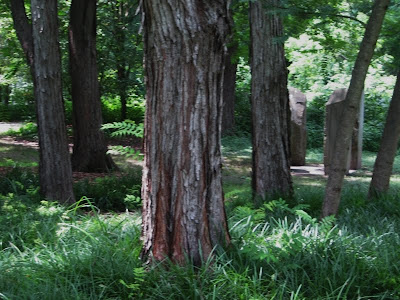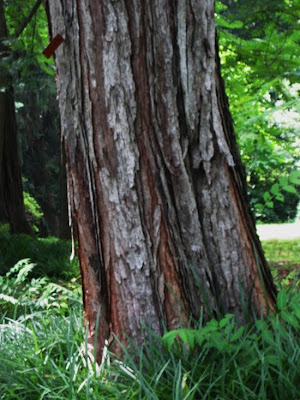Wednesday, March 5, 2014
Toon Tree Mahoganys Cool Climate Relatives
A small genus of trees related to the Mahoganies that are grown for both their shade and also their valuable lumber. They prefer moist, deep well drained, fertile soil in full sun. Propagation is from seed which should be soaked in warm water before sowing.
Toona ciliata ( Ciliate Toona )
Also called Toona australis; it is a fast growing, massive tree reaching 150 feet or more, that is native to rainforest of Australia from northeast Queensland to southeast New South Wales. Some records include: 1st year - 4 feet; 6 years - 15 feet with a trunk diameter of 2 inches; 22 years - 64 feet with a trunk diameter of 7 inches; largest on record - 233 x 72 feet with a trunk diameter of 10 feet ( above the widely buttressed base ). It grows with a solid, upright, red brown trunk and a massive, spreading leafy canopy
The large pinnate leaves are up to 26 or rarely 36 inches in length and are composed of up to 29 ovate leaflets up to 7 x 2.5 inches in size. The attractive foliage is red when new in late spring turning to luxuriant glossy green.
The small, fragrant, white flowers are borne in clusters up to 16 inches in length in spring.
Its timber is very valuable and this tree has been over logged in the past.
Hardy zones 9 to 12 tolerating as low as 10 F and is moderately drought tolerant. It grows well in Sydney, Au. The Ciliate Toon requires yearly rainfall above 30 inches and can tolerate extreme heat as high as 120 F. New growth on young plants is prone to damage from Cedar Tip Moth.
Toona febrifuga ( Vietnamese Mahogany )
A large tree reaching a maximum size of 120 x 60 feet with a trunk diameter of 7 feet. Only hardy in zone 10 and warmer, where frosts do not occur unlike the extremely cold hardy Toona sinensis which is even planted in northern Europe.
Toona sinensis ( Chinese Toon )
Formerly called Cedrela sinensis. This is a fast growing, huge, dense tree native to China ( as far north as Beijing ) and southeast Asia that can reach up to 100 feet however it is sometimes found as a suckering clump of many stems on less than ideal conditions. Some records include: fastest recorded growth rate - 5 feet; largest on record - 120 x 120 feet with a trunk diameter of 6.5 feet; largest in Pennsylvania - 100 x 80 feet @ Lebanon; 80 x 64 x 3.7 feet @ Scott Arboretum. A very large tree also grows at Monticello near Charlottesville, Virginia. It is best grown as a single trunk tree with suckers removed however looks excellent planted as a grove due to their very attractive orange, peeling, very flaking bark. It makes a great street tree and is most spectacular plants in groves in parkland settings.
The large pinnate leaves have a reddish central stalk and reach as large as 34 inches in length on vigorous shoots. The leaves are made up to 16 to 30 leaflets up to 6 x 2 or rarely 9.5 x 3.5 inches in size. Unlike the similar foliages Ailanthus, the Chinese Toon is often missing the terminal leaflet in its leaf arrangement. The foliage is attractive downy, rose-purple in spring turning to deep green and smooth in summer, then turning to orange-yellow in autumn. The foliage smells of onions when crushed. The edible leaves are used in cooking in China. This plant may have anti-cancerous properties, having it as part of the diet may be beneficial.
The fragrant, small white flowers are borne in hanging, terminal panicles up to 20 x 8 inches in size in spring.
The flowers are followed by woody, brown capsules up to an inch in length.
The wood is used for making cigar boxes among other things. Insects including termites do not like the wood.
Hardy zones 5 to 9, requiring a continental climate with long hot summers and cold winters to thrive. Prefers rich, well drained soil in full sun and is both heat and pollution tolerant. Easy to grow, insect pests and disease practically dont exist on this plant. Though rare in most places outside of China, it has become a popular street tree in Philadelphia, PA and Paris, France. Reported to grow in Washington, D.C. at Mt. Hamilton in U.S. National Arboretum though I have still not actually seen it there.
Propagation is easily done from seed or transplanting suckers during the winter.
It tends to sucker more on slopes or soil that is sandy.
* Photos taken on July 16 2010 @ Morris Arboretum, Philly, PA














Flamingo
New foliage is vivid pink transitioning to creamy yellow the finally to lush glossy green.
Sureni
Faster growing with reddish bark.
RELATED TREES
Cedrela odorata
Some records include: fastest recorded growth rate - 6.6 feet with a trunk diameter increase of 1 inch; 6 years - 60 feet with a trunk diameter of 10 inches; 18 years - 82 feet with a trunk diameter of 20 inches; 50 years - 126 feet with a trunk diameter of 2 feet; largest on record - 200 x 110 feet with a trunk diameter of 10 feet.
The pinnate leaves, up to 40 inches in length, are composed of up to 40 leaflets, up to 8 inches in length.
Hardy zones 10 to 12 tolerating as low as 30 F. Very drought and moderately salt tolerant.
Cedrela serrata ( Hill Toon )
A very striking, fast growing large tree native from the western Himalayas to southeast Asia.
Some records include: 27 years - 70 feet with a trunk diameter of 15 inches; largest on record - 100 feet with a trunk diameter of 3.5 feet.
The pinnate leaves, up to 55 inches in length, are composed of up to 33 oblong leaflets, up to 8 x 2.5 inches.
The gray brown bark is deeply ridged.
Hardy zones 9 to 11?
Cedrela toona
A very large tree native to the Himalayas.
Some records include: 30 years - 65 feet with a trunk diameter of 20 inches; 35 years - a trunk diameter of 27 inches; 50 years - 117 feet with a trunk diameter of 17 inches; largest on record - 200 feet with a trunk diameter of 10 feet.
The pinnate leaves are composed of up to 20 leaflets, up to 6 inches in length.
Some records include: largest on record - feet
The leaves are up to inches in length.
Hardy zones 10 to 12?
Subscribe to:
Post Comments (Atom)

I saw so many testimonies about Dr Itua a great HERBAL DOCTOR that can cure all kind of diseases and give you the rightful health to live a joyful life, i didn't believe it at first, but as the pain got worse and my life was at risk after visiting my therapist numeriuos times for combination of treatments. and no changes so i decided to take a try, I contacted him also and told him i want a cure for Vulvar cancer/ Testicular cancer and it was Stage IIIA, he gave me advice on what i must do and he delivered it to me in my state which i use according to his instruction, and today i must say I am so grateful to this man Dr Itua for curing me from Vulvar cancer/ Testicular cancer and for restoring me back to my normal health and a sound life,i am making this known to every one out there who have been living with cancers all his life or any sick person should not waist more time just contact him with his details below- WhatsApp- +2348149277967 Email drituaherbalcenter@gmail.com, believe me this man is a good man with Godly heart, this is the real secret we all have been searching for. Do not waste more time contact him today for you also to live a sound and happy life. he cure the following disease________Thyroid Cancer,Uterine cancer,Fibroid,Angiopathy, Ataxia,Arthritis,Amyotrophic Lateral Scoliosis,Brain Tumor,Fibromyalgia, Fluoroquinolone Toxicity Bladder cancer,Brain cancer,Hiv,Herpes,Esophageal cancer,Gallbladder cancer,Gestational trophoblastic disease,Head and neck cancer,Hodgkin lymphoma
ReplyDeleteIntestinal cancer,Kidney cancer,Hpv,Lung cancer,Melanoma,Mesothelioma,Multiple myeloma,Neuroendocrine tumors
Non-Hodgkin lymphoma,Oral cancer,Ovarian cancer,Sinus cancer,Hepatitis A,B/C,Skin cancer,Soft tissue sarcoma,Stroke,Lupus,Spinal cancer,Stomach cancer,Vaginal cancer,Vulvar cancer,
Testicular cancer,Tach Diseases,Pancreatic Cnacer,Leukemia,Liver cancer,Throat cancer,
Syndrome Fibrodysplasia Ossificans ProgresSclerosis,Alzheimer's disease,Chronic Diarrhea,Copd,Parkinson,Als,Adrenocortical carcinoma Infectious mononucleosis.